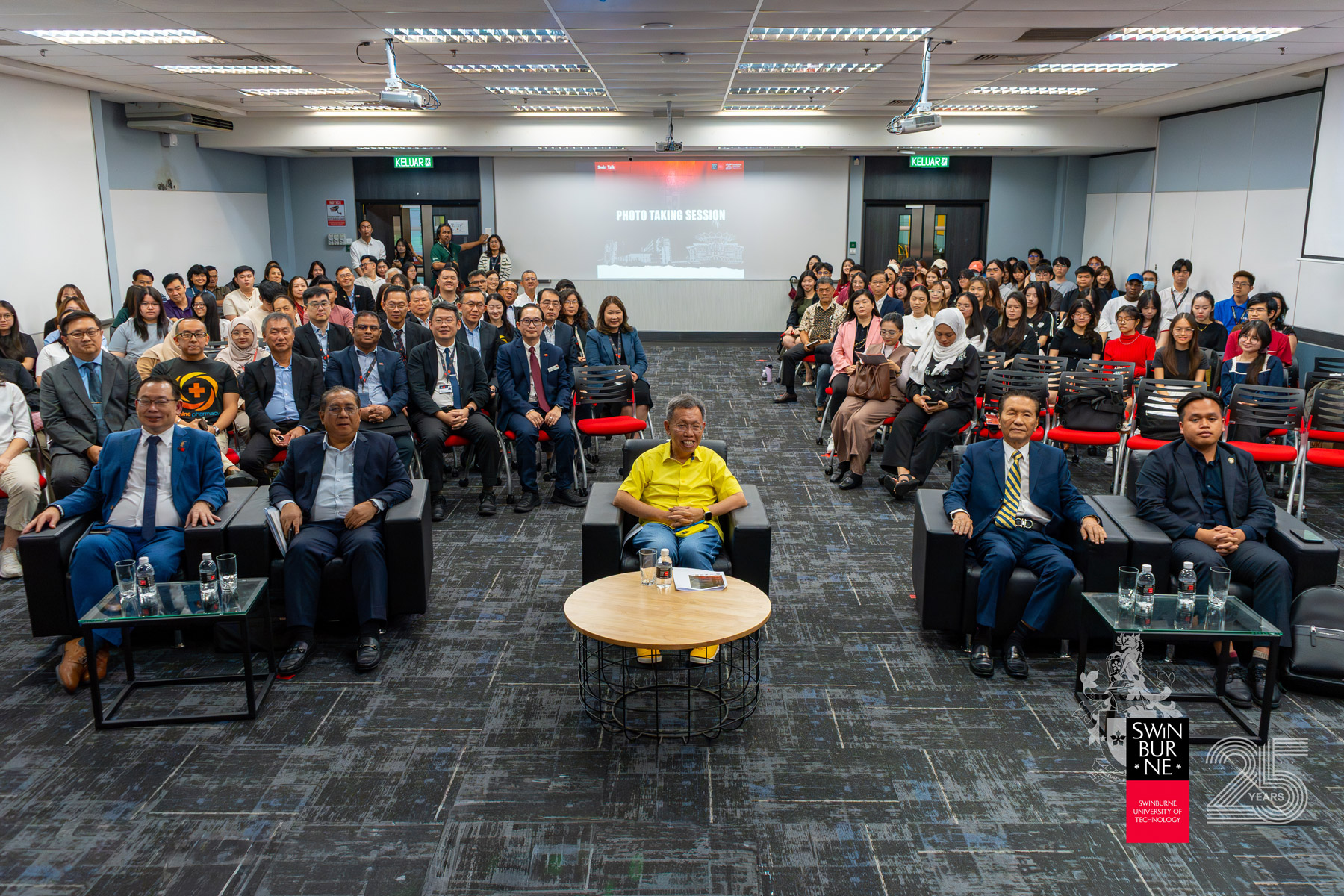KUCHING – As Artificial Intelligence (AI) continues to redefine economics and governance globally, Swinburne University of Technology Sarawak Campus brought the discussion to the forefront through its latest SwinTalk session, themed “AI-Driven Futures: Reimagining Budget 2026 for a Smarter Nation”.
Organised in collaboration with the Sarawak Chamber of Commerce and Industry (SCCI) and the Sarawak Business Federation (SBF), the event brought together government leaders, business professionals, and academics to explore how AI and Malaysia’s Budget 2026 can shape smarter governance, sustainable growth, and equitable digital transformation in Sarawak under the Post COVID-19 Development Strategy (PCDS) 2030.
The SwinTalk session, held at Swinburne Sarawak on 12 November 2025, was graced by The Honourable Datuk Amar Professor Dr Sim Kui Hian, Deputy Premier of Sarawak and Minister for Public Health, Housing, and Local Government Sarawak.
The centrepiece of the event was a fireside chat on “From Allocation to Automation: AI at the Heart of Budget 2026”, where panellists examined how AI adoption across industries can drive innovation, efficiency, and inclusivity in Malaysia’s next economic chapter.
The distinguished panel comprised The Honourable Datuk Amar Professor Dr Sim Kui Hian; Datuk Amar Jaul Samion, Chairman of Swinburne Sarawak’s Board of Directors; Professor Patrick Then, Chief Executive Officer, Sarawak Artificial Intelligence Centre; Mr Kenny Chong Thian Poh, Partner, Crowe Malaysia; and Mr Charles Liew, Founder, SHiNE Pharmacy. The session was moderated by Dr Nivakan Sritharan, Lecturer at Swinburne Sarawak’s School of Business.
Opening the discussion, YB Datuk Amar Professor Sim Kui Hian emphasised how Budget 2026 and Sarawak’s Digital Economy Strategy are reinforcing AI’s role in advancing public health systems and governance efficiency.
“Artificial Intelligence must be used to improve the quality of life for all, especially those in remote areas,” he said, pointing out ongoing efforts to strengthen AI-powered diagnostics, telemedicine, and digital hospital management systems that enhance patient outcomes and service access.
Datuk Amar Jaul Samion shared how AI aligns with the PCDS 2030 priorities, including agriculture, manufacturing, and renewable energy, by enabling data-driven planning and resource optimisation.
He noted that AI supports evidence-based decision-making, predictive analytics, and policy integration, which can accelerate Sarawak’s economic diversification. However, he also acknowledged the foreseeable challenges: data silos, infrastructure gaps, and human capital constraints.
“These challenges can be mitigated through sustained digital investment, inter-agency collaboration, and upskilling the workforce to ensure that AI planning and implementation benefit all sectors equitably,” said Datuk Amar Jaul.
Speaking from a financial and policy standpoint, Mr Kenny Chong Thian Poh highlighted how Budget 2026 could play a pivotal role in incentivising AI investment and strengthening fiscal transparency. He added that AI integration not only transforms industry operations but also enhances tax administration, fraud detection, and financial reporting accuracy.
“With AI improving audit analytics and financial transparency, businesses can manage compliance more effectively while the government strengthens fiscal efficiency,” he said.
He further suggested that future tax policies could expand incentives such as capital allowances, accelerated depreciation, and investment tax exemptions for AI-related assets, encouraging broader participation by businesses and small and medium-sized enterprises (SMEs) in Malaysia’s AI ecosystem.
Professor Patrick Then shared insights on how the Sarawak Artificial Intelligence Centre is translating AI strategies into practical solutions that directly support Sarawak’s economic and social development. He outlined the centre’s focus on AI-enabled productivity in agriculture, logistics, and finance, as well as collaborative projects aimed at enhancing fiscal management and service innovation.
“AI’s impact is not only about efficiency but also inclusivity – building systems that empower communities across Sarawak. Through research, pilot projects, and partnerships, we’re ensuring that AI implementation remains people-centred, transparent, and scalable,” he said.
From a business and human capital perspective, Mr Charles Liew emphasised the role of AI in redefining operations in healthcare and retail. He cited innovations such as AI-powered customer engagement tools, predictive demand systems, and automated inventory management that improve efficiency and consumer trust.
“AI adoption is not just about technology; it’s about people,” he said. “Sarawak’s workforce must be equipped with both technical knowledge and adaptive skills like creativity, ethics, and problem-solving.”
The fireside discussion concluded with a strong consensus that AI must serve as a tool for inclusive progress, not just technological advancement. All speakers concurred that the success of Malaysia’s AI-driven future depends on collaborative governance, continuous talent development, and ethical implementation across sectors.
Swinburne Sarawak’s Pro Vice-Chancellor and Chief Executive Officer Ir Professor Lau Hieng Ho remarked that SwinTalk serves as “a bridge between academic insight and industry practice, fostering dialogue that shapes the future of business and governance in Sarawak”.
Earlier during the event, Ms Zad Chin, Founder of Anygraph, delivered an insightful keynote presentation titled “AI Transformation in Business: What to Expect”.
SwinTalk is Swinburne Sarawak’s flagship thought-leadership platform that brings together policymakers, academics, and industry experts to exchange ideas on current and future challenges. Each session strengthens Swinburne’s commitment to industry-relevant education, research collaboration, and knowledge transfer for the betterment of Sarawak’s economy and society.
For more information on Swinburne Sarawak, visit its website, Facebook page (@swinburnesarawak), Instagram page (@swinburnesarawak), LinkedIn page (Swinburne University of Technology Sarawak Campus), X page (@Swinburne_Swk), TikTok page (@swinburnesarawak), YouTube channel (Swinburne Sarawak), or Xiaohongshu page (@SwinburneSwk).


